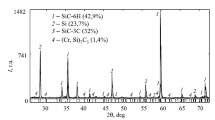Silicon carbide in the \( \beta \) modification with a developed surface and a large pore size was obtained by carbothermal reduction using mesoporous siliceous molecular sieves (SBA-15, KIT-6, MCF, SBA-3). The formation of silicon carbide with high porosity parameters is favored by the use of the KIT-6 mesoporous molecular sieve (MMS) with a three-dimensional structure and a mutually intersecting system of mesopores as matrix, by the close to the stoichiometric C/SiO2 ratio, and also by the higher level of filling with carbon in the pores of the siliceous MMS.


Similar content being viewed by others
References
M. J. Ledoux and C. Pham-Huu, Cattech., 5, 226-246 (2001).
J. Yao, H. Wang, X. Zhang, et al., J. Phys. Chem. C, 111, No. 2, 636-641 (2007).
G. Q. Jin and X. Y. Guo, Micropor. Mesopor. Mater., 60, No. 1, 207-212 (2003).
L. Lianos, A. Berthet, C. Deranlot, et al., J. Catal., 177, No. 1, 129-136 (1998).
W. Zhou, L. Yan, Y. Wang, et al., Appl. Phys. Lett., 89, No. 1, 13105-13105 (2006).
Y. F. Shi, Y. Meng, D. H. Chen, et al., Adv. Funct. Mater., 16, No. 4, 561-567 (2006).
Z. Pan, H. L. Lai, F. C. Au, et al., J. Adv. Mater., 12, No. 16, 1186-1190 (2000).
L. Esposito, D. Sciti, A. Piancastelli, et al., J. Eur. Ceram. Soc., 24, No. 2, 533-540 (2004).
E. Vogli, J. Mukerji, C. Hoffman, et al., J. Am. Ceram. Soc., 84, No. 6, 1236-1240 (2001).
J. Parmentier, J. Patarin, J. Dentzer, et al., Ceram. Int., 28, No. 1, 1-7 (2002).
Z. Yang, Y. Xia, and R. Mokaya, Chem. Mater., 16, No. 20, 3877-3884 (2004).
P. Krawiec, C. Weidenthaler, and S. Kaskel, Chem. Mater., 16, No. 15, 2869-2880 (2004).
Z. Liu, W. Shen, W. Bu, et al., Micropor. Mesopor. Mater., 82, No. 1, 137-145 (2005).
D. Zhao, J. Feng, Q. Huo, et al., Science, 279, No. 5350, 548-552 (1998).
S. G. Gregg and K. S. W. Sing, Adsorption, Surface Area, and Porosity, Acad. Press, New York (1982), p. 94.
E. P. Barrett, L. G. Joyner, and P. P. Halenda, J. Am. Chem. Soc., 73, No. 1, 373-380 (1951).
G. Horvath and K. Kawazoe, J. Chem. Eng. Jpn., 16, 470-475 (1983).
J. Adolphs, Appl. Surface Sci., 253, 5645-5649 (2007).
F. Chen, X. J. Xu, S. Shen, et al., Micropor. Mesopor. Mater., 75, No. 3, 231-235 (2004).
C. Vix-Guterl and P. Ehrburger, Carbon, 35, No. 10, 1587-1592 (1997).
C. H. Liang, G. W. Meng, L. D. Zhang, et al., Chem. Phys. Lett., 329, 323-328 (2000).
Author information
Authors and Affiliations
Corresponding author
Additional information
Translated from Teoreticheskaya i Éksperimental’naya Khimiya, Vol. 51, No. 5, pp. 309-316, September-October, 2015.
Rights and permissions
About this article
Cite this article
Shcherban, N.D., Filonenko, S.M., Sergiienko, S.A. et al. Structure and Porosity of Silicon Carbide Produced by Matrix Method. Theor Exp Chem 51, 320–326 (2015). https://doi.org/10.1007/s11237-015-9432-8
Received:
Published:
Issue Date:
DOI: https://doi.org/10.1007/s11237-015-9432-8




